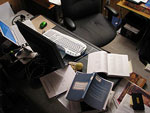The Research Paper: Developing Historical Questions

A way to teach students how to develop historical questions. This is the beginning of a multi-step research paper process that encourages sophisticated historical thinking.
It’s no secret that high schools across the country are turning away from the decidedly “old-school” research paper in favor of shorter writing assignments or a variety of “new-school” technology based projects like blogs or webpages. While these types of assignments are great for building historical thinking skills, we firmly believe that the research paper has been around for a long time for a reason: it’s the best way to engage students in sophisticated historical reasoning and prepare them for the academic world beyond high school. We have developed a comprehensive process with clear steps that walk the students through the creation of a research paper. The first step is for students to create a context-based historical question, giving their research a solid foundation and focus.
Our research paper process guides students using a system with a seven-part structure. In the first part, rather than simply asking students to choose a topic, we ask them to start with a topic of interest, narrow it down to possible subtopics, choose a subtopic, and develop an open-ended historical question to guide their research.
Identify and model the qualities of good historical questions, as described in Handout 1, throughout the course (e.g. as lecture openings, test essays, class discussions, and at the beginning or end of structured debates). As they gain understanding, have students develop good questions as part of classroom activities. When the students seem to have grasped the fundamentals of historical writing, (i.e. thesis, claim, logic, evidence) begin the research paper effort.
- Each student develops a list of subjects about which she is interested (e.g. music, politics, arts, family life). The student then browses reference sources such as textbooks and encyclopedias to identify broad topics of interest.
- The student reads reference sources to establish the basic facts about the broad topics (who did what, where, and when).
- The student narrows the broad topics into manageable subtopics for which evidence (documents, images, etc.) is likely available.
- The student chooses the subtopic that interests her the most but keeps other subtopics on a list in case the chosen subtopic does not have sufficient evidence.
- The teacher models creating good historical research questions. Students practice improving weaker historical questions using Handout 2.
- Students develop historical questions about their chosen subtopics. They work in small groups to improve their questions.
- Students write a passage that identifies the historical context and the historical question. These are turned in to the faculty member for feedback before moving on to locating primary and secondary sources. Remember: questions can and will change as the student does more research.
As part of preparing students for Step 7 of the process above, show kids Handout 3 so that they can see a completed template.
- Some students will skip the preliminary research step. You can usually tell that this happened when their topic description is lacking in detail and specificity. This often results in overly broad questions that will confuse students later. Don’t hesitate to send students back to Step 2 above and reinforce the importance of following all the instructions.
- Some students will develop cultural history questions that may capture their interest, but which are difficult to answer with clear evidence. An example is: “What effects did popular music of the 1960s have on U.S. foreign policy?” Many students choose this because they like the music of the '60s, find the anti-war movement interesting, and assume there is a connection between the music of the era and the choices the U.S. made in Vietnam. However, if held to a strict standard of evidence and logic, only the strongest students are going to be able to convincingly argue any connection between the two. Although it can be a time-consuming process, requiring students to edit and resubmit Step 7 until it works is worth it over the long haul. Even slight changes in the wording of a question will help students avoid dead-ends in their research and ultimately write a better paper.
- Students can be drawn toward modern topics that veer into other social science disciplines and lack a historical perspective. For example, a student might come up with the question: “What is the status of women in U.S. politics?” You might recommend an alteration of this question that connects to the original topic: “What are the origins of the feminist movement in the U.S.?” or “What were the effects of the women’s suffrage movement?”
For more information
Fischer, David. Historians' Fallacies: Toward A Logic of Historical Thought. London: Routledge and K. Paul, 1971.
Furay, Conal, and Michael J. Salevouris. The Methods and Skills of History: A Practical Guide. Wheeling, IL: Harlan Davidson, 2000.
Schmidt, John, and Jeffrey Treppa. Historical Thinker.
The Concord Review, an organization that publishes students’ history research papers.
